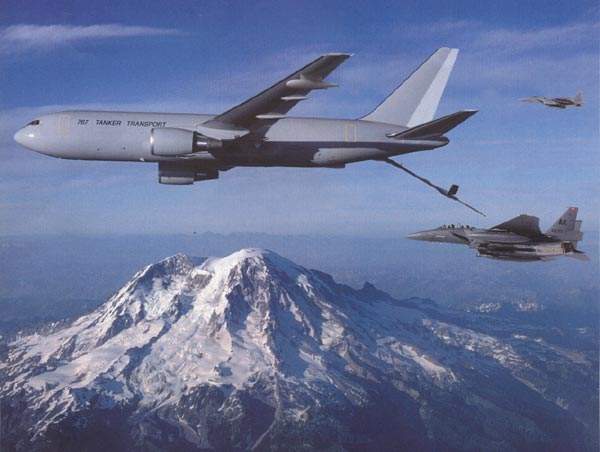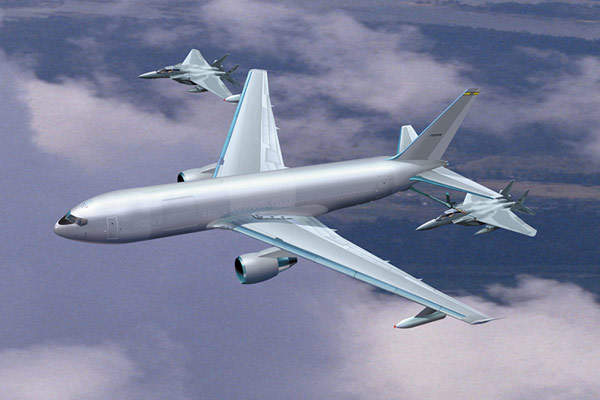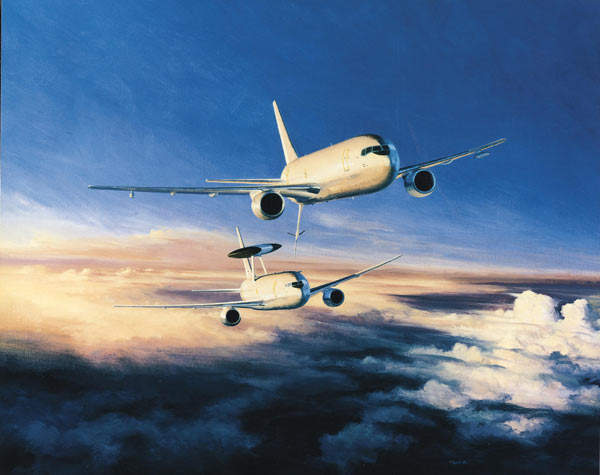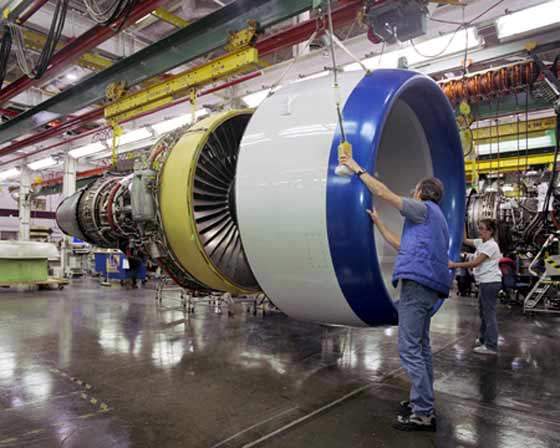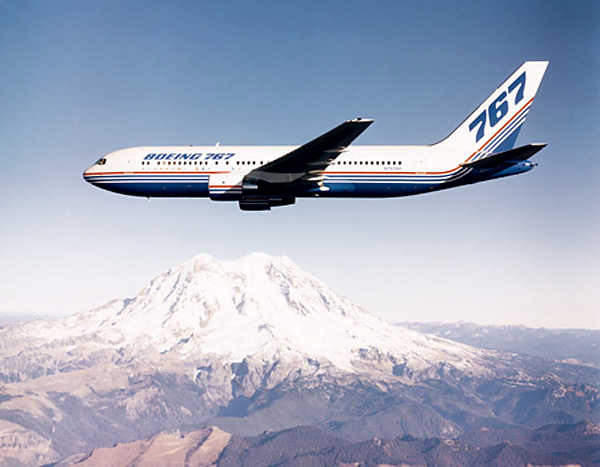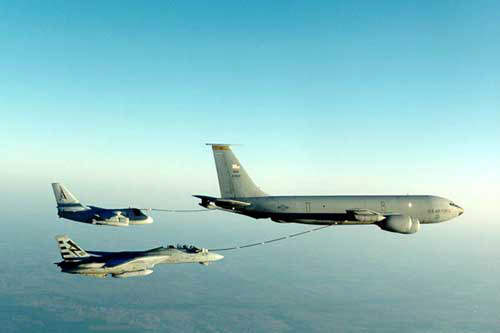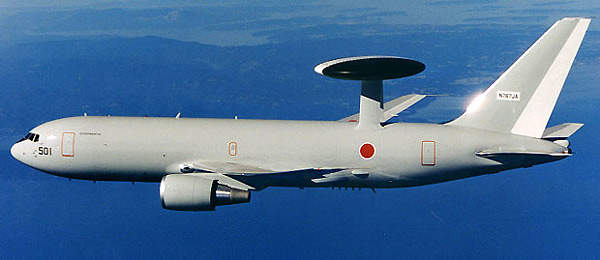The Boeing 767 tanker transport aircraft, designated KC-767 for the US Air Force, is a high-performance version of the Boeing 767-200ER twin-aisle jetliner equipped for fully integrated tanker operations. It is fitted with boom and receptacle refuelling, hose and drogue refuelling, or both.
The commercial 767 first entered service in 1982 and more than 880 aircraft have since been delivered. The cabin of the tanker can be configured for passenger transport as a freighter, convertible (passenger or freighter) or combi (passenger and freighter).
Boeing-767AT Advanced Tanker programme
During the 1980s and in 1990 / 91, Boeing conducted studies directed towards the identification of an appropriate successor to the KC-135 Stratotanker, a derivative of the Boeing 707 jetliner. In 1991, the 707 production line was finally closed and studies confirmed that the long range twin engine 767 was a strong candidate to replace the KC-135.
In May 2003, the US Air Force announced that it would lease 100 tankers to replace the oldest of its KC-135 tankers, subject to congressional approval. The lease would be for six years, starting in 2006. An option to buy at the end of the lease was included in the deal. A Defense Science Board review of the USAF’s proposed lease concluded that further studies were required before a decision could be taken. An analysis of alternatives was completed in April 2006. A revised request for proposals for the KC-X was issued in December 2006.
KC-767 tanker transport aircraft is a high-performance version of the Boeing 767-200ER twin-aisle jetliner.”
Boeing submitted a revised bid for the KC-X in April 2007, the KC-767AT Advanced Tanker was based on a newer version 767-200LR long-range freighter aircraft (rather than the 200ER) with Pratt & Whitney PW4062 engines. The contract was awarded to the Northrop Grumman KC-30 in February 2008.
Boeing appealed against the award and has asked the US Government Accountability Office (GAO) to review the decision in relation to the evaluation award criteria established for the competition. The GAO sustained the protest and in June 2008 recommended that the USAF reopen the bidding process. In September 2008, the US Department of Defense cancelled the competition, citing the need to defer any decision until the next presidential administration took power in January 2009.
Boeing’s KC-767 and Northrop Grumman’s KC-45
Stalemate continued as the Obama administration insisted on a winner-take-all strategy for the US Air Force’s tanker replacement contract, while congress proposed to split the KC-X tanker purchase between the two duelling competitors – the Boeing KC-767 and the Airbus A330-based Northrop Grumman / EADS North America KC-45.
In 2008, Northrop’s team won the KC-X contract, but the award was overturned by the US Government Accountability Office due to procedural breakdowns by the air force. The USAF plans to buy at least 100 KC-X tankers to replace the oldest of more than 400 Boeing KC-135s in its fleet.
Boeing intended to offer either a 767 tanker or the 777 tanker in response to the request from the Pentagon. On 28 September 2009, the Pentagon released the draft request for proposal for KC-X tanker deal.
The source selection in the competition is based on price and non-price factors based on a set of 373 mandatory requirements alongside 93 non-mandatory ‘trade space’ requirements.
The time period required to finalise the deal was expected to be 240 days. The US Air Force planned to award the final deal to acquire 179 tankers in mid-2010; however, this was delayed. Northrop Grumman withdrew from the bidding process in March 2010. In February 2011, Boeing won the final contract to supply the tankers to the USAF under the KC-X programme. The selected Boeing KC-46 was developed on the design of the 767 jet airliner. The initial deliveries are to begin in 2013.
KC-767 international orders
In July 2001, the Italian Air Force (ITAF) ordered four 767 tanker transports in the combi variant. The maiden flight of the first aircraft was in May 2005. The first KC-767A was delivered to the ITAF in January 2011. The second aircraft was delivered in March 2011. These two KC-767A tankers entered service in May 2011. The third and fourth aircraft were upgraded by incorporating new features to improve their capabilities. The upgraded aircraft were delivered in the last quarter of 2011.
All four tankers will replace the ITAF’s B-707T fleet.
In April 2003, the Japanese Air Self Defence Force ordered four of the convertible freighter variant. The maiden flight of the first aircraft was in December 2006. The first two aircraft were delivered in February and March 2008. The third tanker was delivered in February 2009 and the final aircraft was delivered in January 2010.
Boeing announced in May 2009 that the three KC-767J aerial refuelling tankers had achieved initial operational capability (IOC) and have been placed in an active air wing in the Japan Air Self Defence Force (JASDF). Boeing transfered the fourth tanker to Itochu Corporation in December 2009, which in turn was delivered to the Japanese Ministry of Defence on 12 January 2010.
KC-767 aerial refuelling tanker design
The structure incorporates new materials such as improved aluminium alloys, graphite composites and hybrid Kevlar graphite composites, which give enhanced strength, durability and longevity.
The configuration of a commercial 767 for the tanker transport role involves the installation of additional pumps and auxiliary fuel tanks together with the fuel distribution lines below the floor of the main cabin, leaving the main cabin free for cargo, passengers or both cargo and passenger transportation. The concept allows simultaneous refuelling and airlift operations or successive refuelling and airlift missions.
In the cargo configuration, the aircraft can transport 19 standard military 463-L pallets; in the passenger configuration, 200 passengers can be accommodated; and in the combi configuration ten cargo pallets and 100 passengers can be carried.
Cockpit
The 767 Tanker transport aircraft has an advanced two-person, all-digital flight deck. Smiths Aerospace supplied the mission control system, which interfaces with the refuelling system. The control system is a derivative of the flight management system on the commercial Boeing 737. Innovative Solutions & Support supplies the flat-panel pilot’s mission display (PMD) and aerial refuelling operator control display (AROCD).
Rockwell Collins supplies the communications and navigation suite. Kaiser Electro-optics (a Rockwell Collins company) provides head-mounted display systems for the remote aerial refuelling operator.
The 767 tanker transport is being equipped with military avionics, navigation and communications, and an optional defensive aids suite with radar warning receivers and electronic and opto-electronic countermeasures.
767 tanker aerial refuelling capabilities
The 767 aircraft can be modified to accommodate refuelling wingpods and a centreline hose for probe and drogue refuelling. The 767 can accommodate any combination of these configurations. Smiths Aerospace supplies the hydraulically powered hose and drogue refuelling system. The fuselage can also be fitted with a centreline refuelling boom for boom and receptacle refuelling missions.
Boeing produces the boom and Smiths the boom actuation system. BAE Systems was selected to supply the CsLEOS real-time operating system for boom control. The boom can refuel at the rate of 600gal/min, the centreline hose at 600gal/min and the wingpods at 400gal/min.
The USAF air fuel transfer method is through the boom and receptacle air refuelling technique. The US Navy, US Marines and Nato aircraft have traditionally used the hose and drogue air refuelling method.
Aircraft using hose and drogue refuelling include US Navy F/A-18E/F Super Hornet and USMC AV-8B Harrier Plus aircraft. Aircraft using the flying boom refuelling system include the USAF F-111, F-15, F-16, the UK Eurofighter and the French F-1 Mirage. Future aircraft such as the joint strike fighter will be developed for the optional installation of either refuelling system according to the customer country’s operational requirements.
Tankers are fitted with tactical floodlights on the engine pylons, wing pods and the boom area to assist night-time refuelling operations. The drogue itself is fitted with small lights around the perimeter to help night operations.
New-generation highly ruggedised and impact resistant air-to-air refuelling drogues have been fitted with gaseous tritium lights with no wires or moving parts.
Fly-by-wire boom
In January 2007, KC-767’s advanced fifth-generation fly-by-wire boom (a telescoping tube used to deliver fuel to military aircraft) made a series of ‘dry contacts’ with a B-52 bomber assigned to the Air Force Flight Test Center, Edwards Air Force Base, California.
Built on an aerodynamic shape, the advanced boom can transfer 900gal (3,400l) of fuel a minute. It provides for greater precision and control to the operator. The boom automatically corrects its position to reduce potential damage to the receiver aircraft. It is easier to maintain for it has 2,600 fewer parts than previous booms.
KC-767 engines
The two turbofan podded engines are mounted below the leading edges of the wings. ITAF and the Japanese Air Self Defence Force 767 tankers are equipped with GE Aircraft Engines CF6-80C2 engines, rated at 276kN. In March 2004, Boeing announced that the Pratt & Whitney PW4062 engine, rated at 282kN, would be the standard production engine for the USAF and future aircraft.
Performance
The KC-767 can fly at a maximum speed of 915km/h. The cruise speed is 851km/h. The range and service ceiling are 12,325km and 12,200m respectively. The aircraft weighs about 82,377kg and its maximum take-off weight is 179,170kg.
The Global Military Aircraft Market 2011-2021
This project forms part of our recent analysis and forecasts of the global military aircraft market available from our business information platform Strategic Defence Intelligence. For more information click here or contact us: EMEA: +44 20 7936 6783; Americas: +1 415 439 4914; Asia Pacific: +61 2 9947 9709 or via email.

